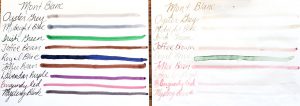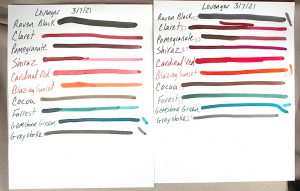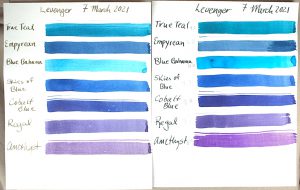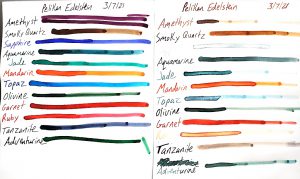While wrapping up our ink tests in 2021, we had a bunch of loose bottles of ink that we tested on the same pieces of Rhodia paper to save paper and space. I left these test samples in the window for six months, and Dawn and I calibrated and tested the pH on these samples at 75.6-degrees Fahrenheit and 50% humidity.
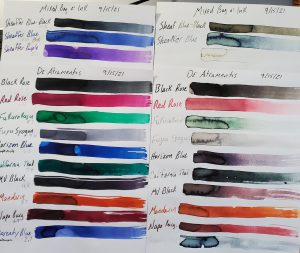
Check out how UV light effected our hodge-podge selection of ink by Sheaffer, DeAtramentis, Iroshizuku, Monteverde and Waterman
As always, we found the results interesting. However, these results are simply raw data. How the chemistry of the inks reacts to the chemistry of a pen’s ink sac or converter is not necessarily dictated by the pH level of the ink. For example: You’ll see below that Waterman Serenity Blue is very acidic with a pH at 2.7, but we’ve used it in vintage pens for years without it doing anything other than standard wear on ink sacs over 5 to 10 or more years. Many dealers other than myself find Waterman inks to be a gold standard of safety for use in vintage pens.
You can see in the photo that most of the ink fared poorly in the light-fast UV test. The Sheaffer inks were the Czech Republic-made variety in blue-black, blue and purple. Their colors are quite pretty when freshly dried. UV light makes the blue-black a faded black and grey. Blue fades badly to a blue-black, and the purple almost complete disappears!
De Atramentis Black Rose holds up reasonably well, though it fades a little. Red Rose fades by about 50%.
We had 2 leftover Iroshizuku inks. The green Fukurokuju is a lovely Irish mint of a color, but it fades really badly in UV light. I’m also a fan of the medium-grey Fuyu Syogun, which has hints of purple and blue. Unfortunately, it fades to almost invisible.
Up next were our first looks at bottled Monteverde ink. Blue Horizon and California Teal are both gorgeous. If you lay it down too wet, it has some nice sheening. Yet, the blue faded to purple and the teal turned grey! Monteverde Black faded heavily to a reddish-grey. Amazingly, Mandarin orange held its color really well. Napa Burgundy faded a bit but generally held its color better than most of the other Monteverde inks.
Last but not least was Waterman’s Serenity Blue. Just about every expert I know insists it is the same formula as Waterman’s Florida Blue, but I swear I see a change. Unfortunately, it behaves much like the old Florida Blue by fading pretty drastically in the sun.
Please look below for the pH readings on all of our inks tested. As a quick refresher, 0 to 6.9 is on the acid side of the scale, with 0 being the extremely corrosive end of the scale. 7 is pH neutral, like pure water. 7.1 to 14 is alkali or base, with 14 being the extremely corrosive side of that half of the scale. Again, our pH results don’t guarantee that the ink is corrosive in your pen, as the chemistry of the ink might mix differently with the chemistry of your ink sac or converters.
SHEAFFER:
Blue-Black 4.5
Blue 3.6
Purple 5.1
IROSHIZUKU
Fukurokuju 8.7
Fuyu Syogun 9.6
MONTEVERDE
Horizon Blue 6.5
California Teal 7.4
Black 4.4
Mandarin 7.7
Napa Burgundy 6.9
WATERMAN
Serenity Blue 2.7


 Shopping Cart
Shopping Cart




